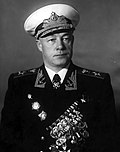Top Qs
Timeline
Chat
Perspective
Admiral of the fleet (Soviet Union)
From Wikipedia, the free encyclopedia
Remove ads
The rank of admiral of the fleet or fleet admiral[a] (Russian: адмирал флота, romanized: admiral flota) was the highest naval rank of the Soviet Union from 1940 to 1955 and second-highest from 1962 to 1991.
This article needs additional citations for verification. (April 2022) |
It was first created by a decree of the Presidium of the Supreme Soviet in 1940 as an equivalent to general of the army, but it was not used until 1944, when Ivan Isakov and Nikolai Kuznetsov were promoted to the rank.
The rank was abolished on 3 March 1955 with the establishment of the rank of admiral of the fleet of the Soviet Union.[1] It was restored in 1962 as the second-highest navy rank.
The rank has been retained by the Russian Federation after 1991.
Remove ads
Insignia
The first insignia was only sleeve insignia.[2] In February 1943, traditional Russian ranks were reintroduced and the sleeve insignia was changed and shoulder straps were added with four "Nakhimov stars".[3] In 1945, the stars were replaced with a single, bigger star to look similar to marshal's shoulder boards.[4]
Remove ads
Officers promoted to admiral of the fleet
Remove ads
See also
Notes
- A literal translation of the Russian "адмирал флота" would be "admiral of the fleet" (адмирал — "admiral", nominative singular, флота — "of the fleet", genitive singular of флот, "fleet"). This equates in meaning and form with the Commonwealth rank "admiral of the fleet", but equally well to the rank "fleet admiral". Either translation is acceptable.
References
Wikiwand - on
Seamless Wikipedia browsing. On steroids.
Remove ads




















